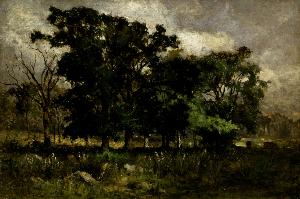Edward Mitchell Bannister
Edward Mitchell Bannister
Place: New Brunswick
Born: 1828
Death: 1901
Biography:
Early Life and Career
Edward Mitchell Bannister was a Black Canadian-American Tonalist painter, born in St. Andrews, New Brunswick, Canada around 1828. He moved to New England in the late 1840s, where he remained for the rest of his life. Bannister's style and predominantly pastoral subject matter were drawn from his admiration for Millet and the French Barbizon School.
Artistic Style and Influences
Bannister was influenced by the Tonalist movement, which emphasized mood, atmosphere, and tonal values over detail and color. His paintings often depicted landscapes with soft, muted colors and a limited palette, creating an overall sense of calm and serenity. Tree Landscape, a painting by Bannister, is a prime example of this style and can be found at the Smithsonian American Art Museum.
Notable Works and Exhibitions
Some of Bannister's notable works include Boston Street Scene (Boston Common), which is housed at The Walters Art Museum, and Newspaper Boy, which can be found at the Smithsonian American Art Museum. Bannister's work was also exhibited at the 1876 Philadelphia Centennial, where he won a bronze medal for his large oil painting Under the Oaks.
Legacy and Recognition
Despite being well-known in his time, Bannister's work was largely forgotten until the 1970s, when it was rediscovered and celebrated as part of the Civil Rights Movement. In 1978, Rhode Island College dedicated its Art Gallery in Bannister's name with an exhibition titled "Four From Providence ~ Alston, Bannister, Jennings & Prophet". Today, Bannister's work can be found in various museums and collections, including the Smithsonian American Art Museum and The Walters Art Museum. For more information on Bannister's life and work, visit https://Wikioo.org/@/Edward-Mitchell-Bannister or https://en.wikipedia.org/wiki/Edward_Mitchell_Bannister. Key Points:
- Born in St. Andrews, New Brunswick, Canada around 1828
- Influenced by the Tonalist movement and French Barbizon School
- Notable works include Tree Landscape, Boston Street Scene (Boston Common), and Newspaper Boy
- Work was exhibited at the 1876 Philadelphia Centennial and won a bronze medal for Under the Oaks
- Legacy was rediscovered in the 1970s as part of the Civil Rights Movement
Wikipedia link: Click Here














